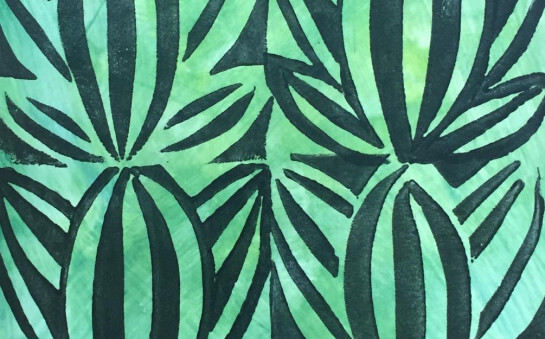Dimensional Clay Surfaces

Go from flat to fantastic by using cut craft foam sheets on moist clay to create two dimensional surfaces for your clay projects.

Wrap and tape newspaper around a cylinder
Wrap newspaper around a heavy cardboard cylinder or plastic PVC pipe. Avoid taping the newspaper to the cylinder so it can be removed later.
Roll a smooth slab that fits snugly around the cylinder.
Roll a smooth slab that fits snugly around the cylinder. Cutting the seam at an angle will create a secure attachment.
Smooth the seam.
Smooth the seam so it is well attached and invisible.
Wrap the craft foam sheet around the clay cylinder.
Cut the 3mm craft foam sheet so it fits snugly around the clay cylinder. Sheets that are too large or overlap will making printing difficult later.
Cut shapes out of the craft foam.
Draw the design with a pen or marker and cut out the shapes.
Leave the edges straight or cut them to suit the design.
Leave the edges straight or cut them to suit the design.
Apply AMACO Underglazes to the craft foam.
Use thick underglaze and a brayer to roll the ‘Underglaze Ink” onto the sheet foam.
Wrap the inked foam sheet around the clay cylinder.
Wrap the inked foam sheet around the clay cylinder and secure it with tape.
Press the foam sheet onto the clay surface.
The foam sheet must make contact with the entire clay surface to get a good print. This can be done with a clean brayer or by simply rolling the cylinder on the table.
Apply AMACO Underglazes with a sponge or brush.
Apply a thick underglaze with a sponge or brush. Using a thick underglaze will give better coverage on moist clay.
Remove the cylinder and paper.
Remove the cylinder and paper.
Smooth the inside seam.
Smooth the inside seam.
Rub the clay from the inside so it protrudes through the openings.
Rub the clay from the inside so it protrudes through the openings.
Remove the craft foam sheet.
Remove the craft foam sheet. This can be washed and used later.
Complete the bottom by adding a slab or pinch walls together.
The clay can be kept round or shaped. Score and add slip if needed before completing the bottom. A slab can be added to create a bottom or simply pinch the clay together. Smooth the outside and inside base. Score and add a coil to the inside seam that will help the form stay together when it’s fired.
Turn the form over to add feet or make them out of existing clay.
Turn the form over to add feet or make them out of existing clay.
Cut the rim.
The top can be cut straight or trimmed to follow the design.



